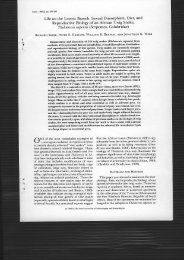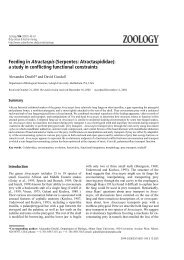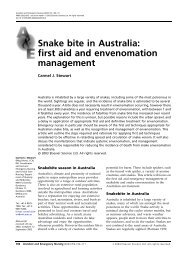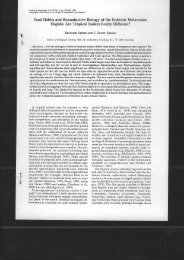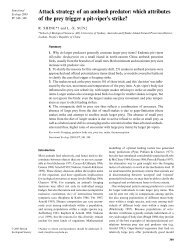Introduction - Kingsnake.com
Introduction - Kingsnake.com
Introduction - Kingsnake.com
You also want an ePaper? Increase the reach of your titles
YUMPU automatically turns print PDFs into web optimized ePapers that Google loves.
Clinical Management of Snakebite in Papua New Guinea Chapter 1<br />
Williams et al (2002) give age and sex-specific data for their series of 283 seriously<br />
envenomed patients at Port Moresby General Hospital. Mean age for males was 21.5 years<br />
(n=170, SD=14.9 yrs, median=16 yrs) and 21.1 years (n=77, SD=16.5yrs, median=14 yrs) for<br />
females. Children 15-years old or under <strong>com</strong>prised 39.9% of cases. The overall male:female<br />
sex ratio was 2.2:1. However, in the 15-29 year age group the ratio of males to females was<br />
4.1:1. Males under the age of 30 years <strong>com</strong>prised 46% of cases. McGain et al (2004)<br />
examining fatal snakebite at Port Moresby General Hospital report that 47% (n=41) were<br />
under 15 years of age, and that males were involved in 53% (n=46) of all cases.<br />
Circumstances of Injury<br />
In the first report on snakebite in Papua New Guinea, Campbell & Young (1961) state that all<br />
15 patients were bitten on either the foot or the leg during daytime hours while the victims<br />
were either walking in or near long grass. Campbell (1964) reported that all but 2/52 patients<br />
were bitten in daylight hours; 96% of cases were from Central province and 73.1% came from<br />
within 80 kilometres of Port Moresby. All but one bite occurred on the lower limbs with<br />
17.3% on the toes, 32.7% on the foot, 15.4% on the ankle and 32.7% on the legs themselves.<br />
Bites occurred when the victims were walking on paths near long grass, or through long grass,<br />
and 23% actually trod on the snake itself.<br />
In his series of 15 cases of Acanthophis spp. bites over a six-year period, Campbell (1966)<br />
reported that all but one bite occurred on the lower limbs, typically on either the dorsum of<br />
the foot or the toes. Eight bites happened when the person stood on the snake. In one case a<br />
man laid down on a snake concealed beneath leaf litter and was bitten on the leg, and another<br />
was bitten on the finger by a snake he accidentally picked up in a pile of cut grass. The other<br />
13 bites were on either the feet or ankles. Three cases involved patients bitten between<br />
6.30pm and 7.30pm, while a fourth patient was bitten at 3.00am in the morning. The other<br />
cases occurred between 8.30am and 5.30pm. In the only other study of proven Acanthophis<br />
spp. envenomation in Papua New Guinea, Lalloo et al (1996) found that 22 of the 32 EIAconfirmed<br />
cases occurred in daylight, and that only two bites did not occur on the lower<br />
limbs.<br />
Reporting bites by Oxyuranus scutellatus canni, Campbell (1967a) shows that all bites<br />
occurred on a lower limb (one of these was bitten on the “middle third” of the leg, and another<br />
on the “lower third”), and occurred between 10.00am and 4.00pm. Lalloo et al (1995a)<br />
observed that 85% of proven Oxyuranus scutellatus canni bites occurred during daylight<br />
among people working in gardens or walking along bush tracks, and that 96.4% of all the<br />
bites were to the lower limbs. All nine cases of presumed Oxyuranus scutellatus canni<br />
envenomation reported by Williams & Bal (2003) took place during daylight and involved<br />
bites to the legs, ankles or feet. One patient was bitten at home, two were bitten in the garden<br />
and the other six cases occurred when patients were walking along bush tracks or dirt roads.<br />
Among Campbell’s (1967c) 13 cases of presumed Pseudechis papuanus bites, most (n=10)<br />
were bitten on either the foot or ankle, while 2 were bitten on the hand or arm and 1 was<br />
bitten on the shoulder. Positive identification of the biting snake was only made in one case<br />
(specimen brought to PMGH), and all of the other cases were more likely to have been caused<br />
by Papuan taipans (Oxyuranus scutellatus canni). Only two positive identifications of P.<br />
papuanus snakebite were made during Campbell’s 7 years at PMGH, and his contention that<br />
it was the most <strong>com</strong>mon cause of snakebite in southern PNG is almost certainly erroneous.<br />
All of the bites occurred in daylight. All nine cases of snakebite involving Pseudechis<br />
papuanus discussed in Lalloo et al (1994) involved bites to the lower limb that occurred<br />
during daylight.<br />
- 1.11 -




